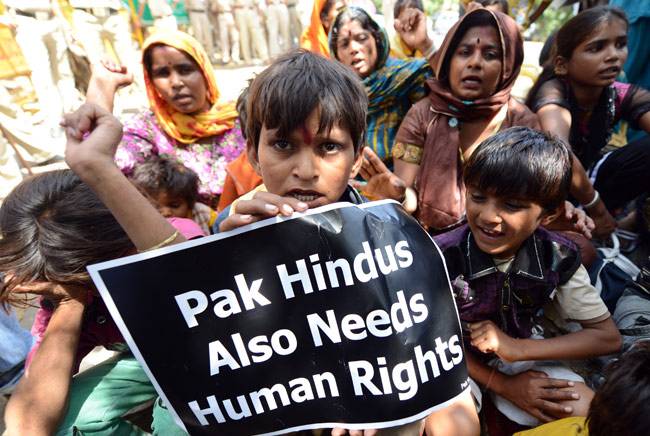Pakistani Hindus can now register as Indian citizens for as low as Rs100 (PKR 155) following the Indian Home Ministry’s gazette notification amending the Citizenship Rules 2009 last week. To further facilitate the registration of Hindus – and other religious minorities – district magistrates in India have been delegated the power of citizenship permission in Maharashtra, Gujrat, Rajasthan, MP, UP and Chhatisgarh.
This should mean that the number of Pakistani Hindus that register as Indians should significantly spike, with the recent average being around 5,000 per annum. That’s 5,000 of our citizens personifying allegiance to India being a safer country than Pakistan. And even though we’re in a perpetual quest to get one over ‘archenemy’ India – whether it’s sports, geopolitics or nuclear warfare – no one seems particularly worked up over thousands of Pakistanis being forced into holding India’s arm up in the boxing ring of tolerance.
Despite the BJP orchestrated Saffron tide having practically made beef biryani a capital offence for Indian Muslims, it still hasn’t propelled a mass exodus. While the terms of 1972’s Simla Agreement have made Pakistani citizenship for them more complicated, a major factor in Indian Muslims’ reluctance to move is their population strength, which at around 15% makes them the country’s second largest religious community. Incidentally, Pakistani Hindus formed around 15% of the total population at the time of Partition as well. The number has now reduced to 2%, owing to a combination of East Pakistan’s separation and the ongoing evacuation of Hindus. Even so, just like the Indian Muslims, Hindus form the second largest religious community in Pakistan as per the 1998 Census.
Why then do Indian Muslims and Pakistani Hindus react to their respective persecution differently? Why aren’t the former abandoning their land as eagerly as the latter?
As the Indian Home Ministry was revamping its Citizenship Rules, Islamist parties in Pakistan have been challenging the PPP-led Sindh government’s recently passed bill against the forced conversion of non-Muslims. With around 1,000 young non-Muslim women being forced to convert to Islam every year in Pakistan, the Islamist parties touting this as their ‘unalienable right’ is owing to the sovereignty granted to Islam by the Constitution. After all, when the law sanctions supremacy for one religion, and grants many exclusive rights to its adherents, converting others to that religion practically elevates their citizenship.
One of the first things that PPP co-chairman Asif Ali Zardari did following his return to Pakistan, after an 18-month self-imposed exile, was to assure the JI Chief Siraj-ul-Haq that the Sindh government would repeal the law against forced conversions. A law that merely protects individuals against being coerced into abandoning their religion, looks set to be decapitated at the altar of radical homogeneity. For Pakistani Hindus, already under attack on multiple fronts, this move could extinguish the already diminishing hopes of a pluralist Pakistan. While all religious minorities have been suffocated under the Islamist takeover of Pakistan, anti-Hindu bigotry has been institutionalised to being synonymous with ‘Nazariya-e-Pakistan’ (the ideology of Pakistan).
The Hindu massacres and temple destructions orchestrated by the likes of Mahmud Ghaznavi, or the forced conversion of 400,000 Hindus proudly owned by Tipu Sultan, adds to their status as Muslim – and hence Pakistani – heroes.
A Grade 6 Social Studies book in Pakistan reads, “The foundation of Hindu set-up was based on injustice and cruelty”. Another Grade 7 book says ‘Hindu’ organisations have been “working to erase the Muslims’ existence from the region,” and continue to do so.
Last year, PTI’s Lal Malhi called out his fellow MNAs resorting to anti-Hindu rhetoric every time they’re criticising Indian policies. Last month, when the law enforcement agencies used tear gas on Pervez Khattak’s envoy in the lead up to the PTI’s proposed lockdown of Islamabad, the KP Chief Minister said the Punjab Police were ‘acting like Hindus’, in an attempt to equate it with the Indian forces’ attacks on Kashmiris.
Making Hindus synonymous with Indians has resulted in the constant rekindling of the hostage population theory. Every time Hindutva extremists target Muslims, or Indian security agencies use violence against Kashmiris, the Pakistani Hindu community bears the brunt. Whether it’s Islamist mobs torching temples, attacking the elderly for eating in public during Ramzan or coercing young girls to convert in cases of forced marriages. In a bid to highlight the human rights abuses faced by Muslims in India, the Pakistani state has acquiesced to violence against Hindus, if not facilitated it. This has weakened Pakistan’s stance over Kashmir internationally, by reducing it to a Pan-Islamist cause and not genuine support for a people’s freedom.
This is why despite the Indian state’s abuses in Kashmir, and the current Hindutva surge, the average Indian Muslim still embraces their country’s national identity. For them, Hindu supremacism contradicts the ‘idea of India’ – that of a diverse, pluralist, secular society.
Hence, in order to safeguard Hindus and religious minorities in general, we would have to revamp the ‘idea of Pakistan’. Whatever the arguments and ideologies in support of its creation might – and might not – have been in the lead up to Partition, Pakistan going forward cannot tout itself as a ‘homeland for Muslims’.
Pakistan would have to reconcile with its multi-pronged paradoxes, starting with nullifying the idea that Hindus and Muslims cannot coexist. While that idea might have been the rallying cry for Pakistan in 1947, it will be the death knell for its progress in 2017 and beyond. Until we make peace with our past, Pakistan would continue to fail its Hindus and other religious minorities.


No comments:
Post a Comment